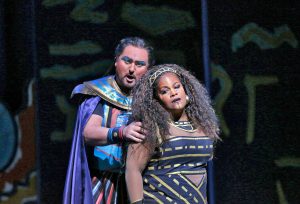Pageantry and Sensuality in Ancient Egypt
San Diego Opera’s splashy new Aida production with sets and costumes designed by Zandra Rhodes—courtesy of Houston Grand Opera and three other companies—is nothing less than a visual orgy, an avalanche of radiant jewel tones and sensual costumes that capitalized on the opera’s exotic setting and abundant pageantry.
Although the company assembled a strong cast and the orchestra gave
Verdi’s sumptuous score its due, the spectacle overpowered the drama, especially in the opera’s first half. It was not until the third act that soprano Latonia Moore’s passionate and vocally opulent arias brought the drama to the fore and made the audience feel the tragic depth of Aida’s plight. Moore’s bold dramatic soprano voice unleashed the despair and anger of the enslaved Ethiopian princess, yet displayed sufficient spinto luster to reveal her tender side, her longing for her verdant homeland and grief for a lover about to be taken from her.If only Italian tenor Walter Fraccaro had expressed Moore’s emotional range. His bright Italianate tenor quality has that ping that opergoers look for in a lead tenor, but he had one color, one expression, and one dynamic level the whole evening.
Always a company favorite, bass baritone Mark S. Doss made a gripping Amonasro, Aida’s father and King of Ethiopia, also captured by the victorious Egyptians. His hair and costume suggested a Rastafarian rock star, but his firmly projected bass tones conveyed regal authority and urgency. German bass Reinhard Hagen gave equal authority to Ramfis, the Egyptian High Priest, and bass-baritone Ashraf Sewailam (just seen in San Diego Opera’s Murder in the Cathedral) projected a rather stoic King of Egypt.Jill Grove’s austere Amneris seemed to be channeling Puccini’s ice princess Turnadot. Wanting to possess Radames, the American mezzo-soprano did not reveal much passion for him. Like Fraccaro, she sang beautifully, but an opera is not a concert.
Stage director Andrew Sinclair took his cues from Rhodes’ sets,
emphasizing the sensual, from the lurid human sacrifice in the Temple of Vulcan scene to the flirtatious, scantily clad male servers for Amneris’ ladies-in-waiting. (Male counterparts to those infamous 1960s Playboy bunnies?) And the climactic entombment scene at the edge of the stage lacked that sense of noble tragedy that this Liebestod should instill. Choreographer Kenneth von Heidecke imagined some convincing angular movements for the female dancers in the scene at the Temple of Vulcan that echoed the stylistic poses found in ancient Egyptian art and artifacts. The rest of his choreography proved athletic, if not particularly period specific.Rhodes’ eye-popping costumes, notably the brilliant, flared skirts for the bare-chesterd Egyptian males and the electric green gowns for the females of the Egyptian court would have been perfect for a Las Vegas revue, but here they bordered on distraction. Think of David Hockney’s bold and immediately identifiable opera designs: they make a strong first impression, but don’t compete with the opera’s dramatic impetus.
In the pit, Daniele Callegari brought cohesive and vibrant support from the orchestra throughout the work. I would salute in [php snippet=1]particular principal oboe Sarah Skuster’s many solos (especially in the Nile River scene) for their supple radiance that embodied the oriental flavor Verdi so eloquently evoked. It was another triumphant showing for the chorus, although their rousing voices competed with so many other aspects of this production for our attention.
This production ends the San Diego company’s 2013 season, one of their stronger seasons in recent years. The 2014 season was recently announced, and we do have another Verdi gem to anticipate, A Masked Ball with Polish tenor Piotr Beczala and mezzo Stephanie Blythe. That alone is enough to keep my anticipation fired until 2014.
[box] This production continues at Civic Theatre on April 23 and 28 at 7:00 p.m. and on Sunday, April 28, at 2:00 p.m. Tickets: 619. 533-7000; www.sdopera.com.[/box]

Ken Herman, a classically trained pianist and organist, has covered music for the San Diego Union, the Los Angeles Times’ San Diego Edition, and for sandiego.com. He has won numerous awards, including first place for Live Performance and Opera Reviews in the 2017, the 2018, and the 2019 Excellence in Journalism Awards competition held by the San Diego Press Club. A Chicago native, he came to San Diego to pursue a graduate degree and stayed.Read more…



![Mark Doss as Ramfis [photo (c) Ken Howard]](http://sandiegostory.com/wp-content/uploads/2013/04/aida_Mark-Doss-300x218.jpg)
![Aida dancers in the Temple of Vulcan [photo (c) Ken Howard]](http://sandiegostory.com/wp-content/uploads/2013/04/aida_ballet-Tem-Vulc-300x200.jpg)